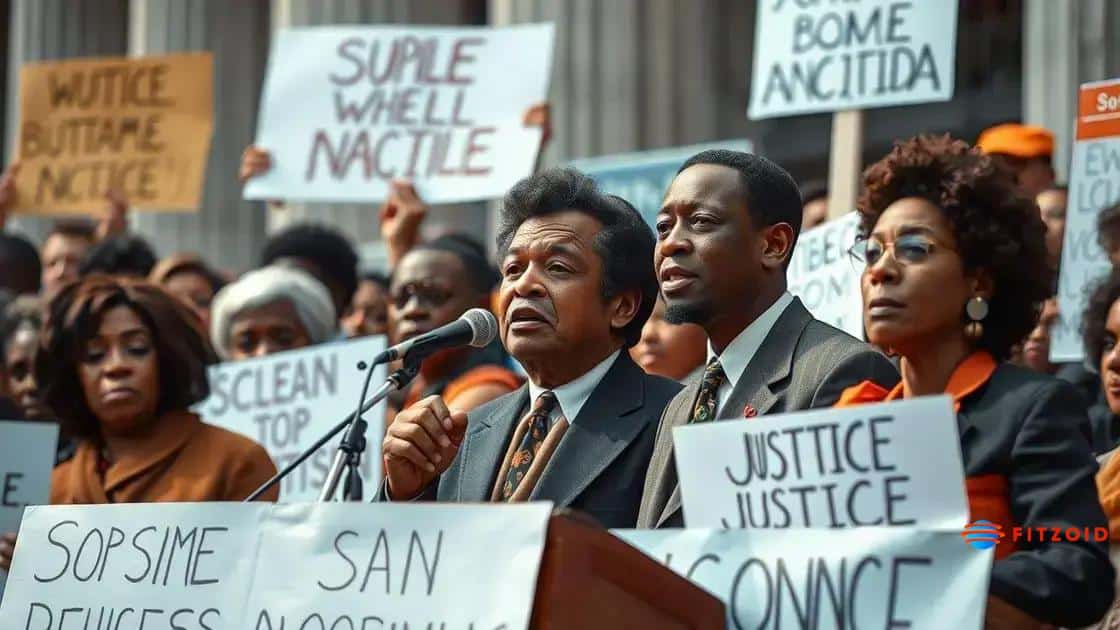Civil rights advocacy movements: Uncovering their impact
Anúncios
Civil rights advocacy movements utilize social media and new technologies to amplify voices, mobilize protests, and engage younger generations, driving the ongoing fight for justice and equality in society.
Civil rights advocacy movements play a crucial role in shaping our society and pushing for justice. Have you ever wondered how these movements spark change and inspire communities? Let’s delve into their significance and lasting effects.
Understanding the history of civil rights advocacy
Understanding the history of civil rights advocacy is essential to grasp the progress made in the fight for equality. These movements highlight how individuals and groups have united over time to challenge injustice and promote fairness.
Anúncios
Key Historical Events
Several pivotal events have defined civil rights advocacy. These moments mark significant shifts in public perception and legislation.
- The Montgomery Bus Boycott in 1955, which stood against racial segregation.
- The March on Washington for Jobs and Freedom in 1963, where Martin Luther King Jr. delivered his iconic “I Have a Dream” speech.
- The Civil Rights Act of 1964, a landmark law prohibiting discrimination based on race, color, religion, sex, or national origin.
Over the decades, activists have played a crucial role in shaping legislation and public opinion. Their efforts remind us that change often requires **courage** and **perseverance**.
Anúncios
Grassroots Movements
Grassroots efforts have been vital for driving change in communities. These local initiatives connect individuals and raise awareness about civil rights issues:
- Community organizing to support voters’ rights.
- Education campaigns to inform about legal rights.
- Solidarity protests that unite various groups.
Such movements demonstrate that advocacy is not only about high-profile events; it’s also about the daily work done in local communities.
With each passing generation, new issues arise, requiring ongoing advocacy. The legacy of civil rights movements continues through today’s activists, who address issues like racial injustice and equality for marginalized groups.
| Theme | Summary | Examples |
|---|---|---|
| Historical Foundations | Key events that shaped the civil rights movement. | Montgomery Bus Boycott, March on Washington, Civil Rights Act of 1964 |
| Influential Leaders | Individuals who led and inspired change. | Martin Luther King Jr., Rosa Parks, Malcolm X, Ella Baker |
| Legislative Milestones | Laws that advanced civil rights protections. | Civil Rights Act (1964), Voting Rights Act (1965), Brown v. Board (1954) |
| Role of Social Media | Digital platforms that amplify advocacy efforts. | #BlackLivesMatter, live protest updates, viral awareness campaigns |
| Grassroots Movements | Community-led efforts to drive local change. | Voter registration drives, youth organizing, educational workshops |
| Future Strategies | New tools and focus areas for modern advocacy. | AI, global coalitions, intersectionality with environmental and social justice |
Key figures in civil rights movements

Key figures in civil rights movements have greatly influenced the quest for equality and justice. These individuals have dedicated their lives to advocating for the rights of others and have inspired countless individuals along the way.
Martin Luther King Jr.
One of the most recognized leaders is Martin Luther King Jr.. Known for his nonviolent approach, he played a crucial role during the 1960s. His “I Have a Dream” speech remains one of the most powerful calls for justice in history.
Rosa Parks
Another vital figure is Rosa Parks, often called the “mother of the civil rights movement.” Her refusal to give up her bus seat sparked the Montgomery Bus Boycott, a pivotal moment in civil rights history.
Malcolm X
Malcolm X brought a different perspective to the movement. He advocated for Black empowerment and self-defense, emphasizing the need for economic independence within the Black community.
- His speeches inspired many to embrace their identity and demand justice.
- He formed the Organization of Afro-American Unity to promote the social and economic uplift of African Americans.
- His legacy continues to influence discussions about race and identity today.
These leaders, along with many others, have paved the way for future generations. Their efforts remind us that true change often comes from the courage of individuals willing to fight for what is right.
Other noteworthy figures include James Baldwin, a prominent writer and activist who voiced the struggles of the Black community, and Ella Baker, who emphasized grassroots organizing and youth involvement in movements.
Each of these individuals made unique contributions, creating a richer tapestry of the civil rights landscape. Their stories continue to engage and inspire people to **act** for justice and equality in our world.
Major milestones in advocacy efforts
Major milestones in advocacy efforts for civil rights serve as markers of progress and highlight the ongoing struggle for equality. These events shaped the course of history and inspired future actions.
The Civil Rights Act of 1964
One of the most significant milestones is the passage of the Civil Rights Act of 1964. This landmark legislation prohibited discrimination based on race, color, religion, sex, or national origin. It was a crucial step in the long battle for racial equality.
The Voting Rights Act of 1965
Another vital moment came with the Voting Rights Act of 1965. This law aimed to eliminate various barriers that prevented African Americans from exercising their right to vote. It ensured that all Americans had equal access to the democratic process.
- Banned literacy tests and other discriminatory practices.
- Provided for federal oversight of voter registration in areas with a history of discrimination.
- Significantly increased voter registration among African Americans.
The impact of these laws was monumental, leading to increased political representation for marginalized communities.
Brown v. Board of Education
The Brown v. Board of Education decision in 1954 was another turning point. This Supreme Court ruling declared that racial segregation in public schools was unconstitutional. It set a precedent for challenging segregation in other areas of society.
These milestones reflect the dedication of countless activists who fought tirelessly for justice. They paved the way for further advancements in equality and inspired future generations. Each success helps build momentum in the ongoing struggle for civil rights.
The impact of social media on civil rights

The impact of social media on civil rights has changed the way movements operate today. Platforms like Twitter, Facebook, and Instagram have become powerful tools for raising awareness and organizing events.
Amplifying Voices
Social media allows individuals to share their stories and experiences, which helps to humanize issues related to civil rights. This amplification of voices brings attention to injustices that might otherwise go unnoticed.
- Creations of hashtags like #BlackLivesMatter have mobilized thousands to speak out against racism and police brutality.
- Social media campaigns enable users to share real-time information about protests and gatherings.
- Activists can reach a wider audience, encouraging more people to join the fight for equality.
As a result, social movements gain momentum quickly and can affect real change in their communities.
Mobilizing Protests
The use of social media has transformed how protests are organized. In the past, arranging a protest required significant logistics and planning. Now, a post or tweet can gather supporters in a matter of hours.
This immediacy means that activists can respond to events as they unfold, often leading to larger and more impactful gatherings. Social media also provides a platform for live updates during events, keeping supporters informed and engaged.
While social media is powerful, it is not without challenges. Online misinformation can spread quickly, sometimes undermining the efforts of activists. Despite these hurdles, the influence of social media on civil rights is undeniable.
It fosters a sense of community among individuals fighting for similar causes and provides resources that were previously unavailable. Overall, social media has revolutionized the civil rights landscape, making the fight for justice accessible and inclusive for many.
Future of civil rights advocacy movements
The future of civil rights advocacy movements promises to be dynamic and impactful. As society faces new challenges, advocates continue to innovate and adapt to ensure equality for all.
Emerging Technologies
Emerging technologies are shaping how advocacy is conducted. Social media, artificial intelligence, and data analytics play crucial roles. These tools help activists reach wider audiences and gather important insights.
- Social media allows for rapid mobilization and awareness.
- Data analytics can identify trends and inform strategies.
- Virtual reality experiences can provide immersive education about civil rights issues.
These technologies empower movements to operate more efficiently and effectively. As technology evolves, so will the strategies used by advocates.
Global Connections
Globalization has created stronger connections between civil rights movements across different countries. Activists share resources and strategies, learning from each other’s successes and challenges.
This interconnectedness fosters solidarity among advocates. It also encourages diverse voices to join the conversation about equality and justice. As issues transcend borders, global movements can collaborate to tackle fundamental problems, such as racism and inequality.
Looking ahead, movements will likely focus on issues such as environmental justice and access to education. Advocates are already addressing the intersection of civil rights and climate change, emphasizing that marginalized communities often bear the brunt of environmental impacts.
The future holds promise, but it will require dedication and resilience from advocates. They must stay committed to the principles of justice and equality. Meanwhile, engaging younger generations will be essential to keep the momentum going.
Looking Ahead: The Path of Civil Rights Advocacy
The future of civil rights advocacy movements is bright and full of potential. As technology continues to advance, it offers new ways for activists to connect, mobilize, and advocate for justice.
Global connections also enhance the strength of these movements, allowing for shared knowledge and support. Through collaboration and innovation, advocates can address pressing issues like inequality and climate change effectively.
Engaging younger generations will be key to sustaining momentum. Their energy and ideas will shape the future of civil rights, ensuring that the values of justice and equality remain at the forefront of societal change.
Everyone has a role to play in this journey, reinforcing the idea that together, we can create a fairer world for all.
FAQ – Frequently Asked Questions about Civil Rights Advocacy Movements
How has social media changed civil rights advocacy?
Social media has transformed civil rights advocacy by allowing activists to quickly mobilize supporters, share stories, and raise awareness about important issues.
What are some major milestones in civil rights history?
Key milestones include the Civil Rights Act of 1964 and the Voting Rights Act of 1965, which helped end discrimination and expanded voting access.
Why is it important to engage younger generations in activism?
Engaging younger generations is crucial because they bring new energy, ideas, and perspectives that can help sustain and innovate civil rights movements.
What future challenges might civil rights movements face?
Future challenges may include addressing issues like racial inequality, climate justice, and navigating the effects of misinformation on social media.





